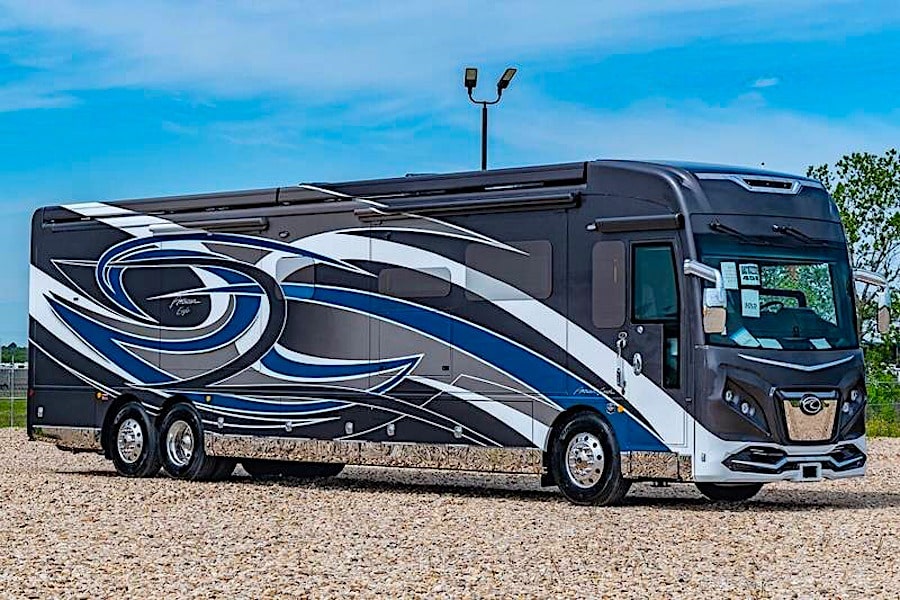Thanks for your support! If you make a purchase using our links in this article, we may make a commission. And, as an Amazon Associate, I earn from qualifying purchases. See the full disclosure here.
One of the most common questions we are asked when it comes to Class A motorhomes is… gas vs. diesel RVs – which motorhome is best? This question has been debated since the 1970s and continues to this day.
In our quest to explore both sides of this coin, we’ve come up with one solution: it boils down to personal choice. Gassers (the slang for Gas Class A RVs) have their benefits and cost less. But almost everyone has had that dream of owning that ultimate multi-million dollar diesel Class A motorhome.
To help you decide, we’ll show you some key topics and examples that represent the pros and cons of the diesel vs. gas motorhome debate. You’ll discover there’s one out there for almost every type of RV lifestyle.
- Small Gas Class A Motorhomes (27-33 Feet)
- Engine Lifespans
- Full-Size Gas Class A Motorhomes (35-40 Feet)
- Fuel Efficiency and Capacity
- Full-Size Front End Diesel Class A Motorhomes (35-40 Feet)
- Maintenance and Servicing
- Luxury Level Diesel Pusher Class A Motorhomes (40-45 Feet)
- Insurance Rates
Small Gas Class A Motorhomes (27-33 Feet)
Weekenders, tailgaters, and part-time RVers will find small gassers like the Coachmen Mirada 29FW perfect for their camping lifestyle. This 30-foot gasser offers all of the best features both inside and out. It’s also one of the few Class A RVs with an outdoor kitchen.
The average camper length limit in national parks is around 30 feet. The smallest Class A RVs measure 27 feet and are on gas chassis. As long as the park roads don’t have tight turns or are too rough, a motorcoach like the Mirada will take your family to the most scenic landscapes our country has to offer.
Young couples, families, and retirees are gravitating towards short gassers. People find them more comfortable to drive since they don’t have a long back end, have upgraded interiors that fit everyone, and still have enough horsepower to flat-tow their passenger vehicle.
Features and amenities on average will be near residential sizes. You’ll have to be strategic with your interior storage. RV manufacturers do their best to provide the most storage possible, but you’ll find the most storage in your external bays. It’s always a good idea to have a stack of plastic bins available in your bays and vacuum storage bags for your soft items.
Main Specs For The Coachmen Mirada
- Length: 30.7 Feet
- GVWR: 18,000 Pounds
- Chassis: Ford F-53
- Engine: Ford 7.3L V8- 430 hp @ 475 lb./ft.
- Tanks: Fuel- 80 gallons/ Fresh- 50 gallons/ Gray-46 gallons/ Black- 46 gallons
- Sleep: 8 People
- Price Point: $98,000- $118,000
Engine Lifespans
Gassers do have a lifespan. A gas RV engine lasts either 20 years or 200,000 miles. With proper maintenance, the engine will last longer, but it may require replacing essential components.
Diesel RV engines can flip 500,000 miles and keep on rolling. Diesel Class A motorhomes use the same engines that commercial and industrial machinery use. The individual components of these powerplants can handle the incredible stress heavy equipment goes through every day.
Full-Size Gas Class A Motorhomes (35-40 Feet)
In decades past, the line between gassers and diesels was clear. Gas Class A motorhomes reached a certain point, and the RV manufacturers would build their diesel Class A RVs from that point on. In today’s market, top-end gassers blend in with mid-grade diesels to the point where it’s hard to distinguish one from the other.
Forest River has three levels of the Georgetown motorhome. The Series 7 is a gas Class A RV but has all of the diesel motorhome features, even the spectacular exterior graphics package. The 36K7 model is a Class A motorhome with bunk beds. Families can use this motorcoach for extended trips or live the full-time RV lifestyle.
You’ll find a king-size bed, plush dinette, and power theater seat sofa that are the same quality as diesel Class A RVs. The over 22 cubic foot residential refrigerator runs off of the 2,000-watt inverter and all of the electronics. You can control and monitor many RV functions through the control panel or the mobile device app.
Main Specs For The Forest River Georgetown
- Length: 40.1 Feet
- GVWR: 24,000 Pounds
- Chassis: Ford F-53
- Engine: Ford 7.3L V8- 430 hp @ 475 lb./ft.
- Tanks: Fuel- 80 gallons/ Fresh- 86 gallons/ Gray- 52 gallons/ Black- 52 gallons
- Sleep: 10 People
- Price Point: $158,000- $170,000
Fuel Efficiency and Capacity of Gas vs Diesel RVs
The average fuel economy for Class A motorhomes is 7-13 miles-per-gallon (mpg) for diesels and 6-10 mpg for gassers. Compared to passenger vehicles, this is low. Suppose you compare this to heavy-duty pickup trucks and other vehicles of this caliber. In that case, this fuel efficiency is good considering all of the weight and further stresses the motorcoach goes through.
When it’s time to fuel up, the fuel tanks are different. Gas Class A RVs have a fuel tank of 80 gallons. Diesel Class A motorhomes have fuel capacities that range from 100-200 gallons. The size of the tank usually comes from the auto manufacturer.
When the RV manufacturers receive the chassis, the essential automotive components, including the fuel system, are already in place. The RV engineers work with the auto engineers and work around their specifications, so they don’t have to alter anything that’s already in place.
Full-Size Front End Diesel Class A Motorhome (35-40 Feet)
Recently, Freightliner introduced a FRont End Diesel (FRED) chassis that RV manufacturers have taken advantage of in their latest floor plans. FRED chassis give buyers the option to have a gas floor plan and diesel performance.
The FRED chassis are less powerful than the rear diesel pusher (DP) version, and the engine noise is louder. The generator is under the driver’s area on the DP chassis, giving RVers a quieter sleeping experience. Most FRED owners don’t mind too much since the generators have noise reduction technology, and the insulation dampens sound.
A great example of a FRED is the Newmar Canyon Star 3929. In 2020, the RV manufacturer starting offering this traditionally gas Class A motorhome with a diesel engine. To make it comparable to the previous full-size gasser, we chose this model because it’s a Class A motorhome with a bunkhouse in the rear.
Newmar cracked the code to the mystery of giving kids their own space in motorhomes with two twin-sized bunks and a half-bath. There’s plenty of wardrobe space in there. One of the closet spaces has washer and dryer prep installed for those that want to avoid campground laundromats. You’ll also find the best features and amenities Newmar has to offer at their top-end gas/lower-end diesel level.
Main Specs For The Newmar Canyon Star 3929
- Length: 39.11 Feet
- GVWR: 30,000 Pounds
- Chassis: Freightliner MC
- Engine: Cummins B 6.7L V8- 340 hp @ 340 lb./ft.
- Tanks: Fuel- 80 gallons/ Fresh- 75 gallons/ Gray- 60 gallons/ Black- 92 gallons
- Sleep: 10 People
- Price Point: $180,000- $280,000
Maintenance and Servicing of Gas vs Diesel RVs
The maintenance issues between gassers and diesels are going to have trade-offs. For example, Diesel engines now require Diesel Exhaust Fluid to convert hazardous chemicals to harmless nitrogen and water. To protect your gasser’s engine, you need to add a fuel stabilizer to your gas tank. These products have minimal costs but are vital to protect your RV.
Generally, automotive servicing will be more expensive for diesel Class A motorhomes than gas Class A RVs. You can expect to pay around $150 to $200 for a complete oil change for your gasser. Diesels will be in the neighborhood of $400-$450.
There is some relief when it comes to repairs. Diesels breakdown less often. Their chassis and frames can stand up to the road’s stresses and RV life a lot longer. The downside is when they do need repairs. You’ll pay double or triple the price of a comparable gasser part, but it’ll happen less often. Like any RV, if you keep up with your preventive maintenance, most problems are avoidable.
Luxury Level Diesel Pusher Class A Motorhome (40-45 Feet)
It’s strange to see that the biggest RVs usually sleep the least amount of people to the untrained eye. For those that understand the full-time RV lifestyle, it makes perfect sense. When your entire existence fits within an RV, you want as much room as possible to stretch out. You and your traveling companion enjoy being together, but everyone needs their own space during the day.
Luxury level Class A motorhomes have residential or near residential-sized furniture, appliances, and other features. These diesel pushers are the most home-like drivable RVs on the road. In case family or guests stay over, they have fold-out sofas and multiple bathrooms, so everyone is comfortable.
One name that’s known as the “Cadillac of RVs” is American Coach. The Eagle 45K is their flagship model. This 45-foot rolling palace has the latest technology and ultimate features imaginable. You’ll find a master bedroom suite in the back with a king-size bed that has a head lift system and memory foam mattress.
The master bathroom has dual vanities, and the shower is complete with marble tile. The galley kitchen has a residential refrigerator, plenty of counter space, and full-size cooking appliances to cook any gourmet meal possible. You’ll never have to worry about cold feet with the underfloor heating and other various luxury comforts.
Main Specs For The American Coach Eagle 45K
- Length: 44.11 feet
- GVWR: 51,000 Pounds
- Chassis: Liberty Bridge
- Engine: Cummins ISX15 V8- 605 hp @ 1,950 lb./ft.
- Tanks: Fuel- 150 gallons/ Fresh- 105 gallons/ Gray- 75 gallons/ Black- 50 gallons
- Sleep: 4 People
- Price Point: $500,000- $600,000
Insurance Rates for Gas vs Diesel RVs
If you don’t see the pattern already, insurance rates are going to follow it. Diesel Class A motorhomes are going to be more expensive than gas Class A RVs.
If you’re new to how insurance rates for RVs work, the system is different than your car or home policies. A policy lasts for 12 months. It covers you while you’re traveling like a vehicle. It also covers you like a second home and the campsite you’re on. Coverage includes several things:
- Comprehensive and Collision
- Liability
- Personal Injury (you and a third party)
- Property Damage
- Vacation Loss (your vacation is ruined due to an accident)
- Car rental (not RV rental)
When you see the rates, at first you’ll be amazed. RV insurance has the best rates of any coverage when you compare it to other types. On new Class A motorhomes, expect to pay in the thousands. To give you some perspective, Michigan has the highest average rate of 2020 (almost $4,500) and Oregon had the lowest ($1,108) using all categories or RVs.
Used Class A motorhomes have better rates than new models. Part-time RVers pay less than full-timers. Your driving record and where you live can save you some money on your rates. You may get a discount if your vehicle or home is with the same company. Here are some popular RV insurance companies with good rates:
Cost-Effective Ways to Decide Which is Best: Gas vs Diesel RVs
The best way to decide which side of the gas vs. diesel Class A motorhome debate you fall on is to rent them. You can check out the latest models on Outdoorsy to see both engine types in your local area. Spend a few weekends trying out different floorplans to determine what fits you best.
When you rent from a peer-to-peer company, you’re getting RVs from real owners. They can tell you about their own experiences and why they chose this particular motorcoach. Once you’ve gained some first-hand experience, you’ll be better equipped to make your own decision and buy what’s right for you.
Happy Trails!
Related Reading:
1️⃣ Class A vs Class C Motorhome and How to Choose
2️⃣ Fifth Wheel vs Class A Motorhome – Pros and Cons to Help You Choose
3️⃣ 8 Small Class A RVs Under 30 Feet
4️⃣ Where to Find the Best Class A Motorhome Rental
Brian Newman – Author and Full Time RVer
Although he’s from Motown, Brian Newman is a legacy RVer that grew up on I-75. He, and his wife have enjoyed the full-time RV lifestyle since 2017.
Like John Madden, he hasn’t “worked” in years because he gets to write about his passion. When he’s not working, he supports his daughter’s dog rescue efforts and disability causes.


